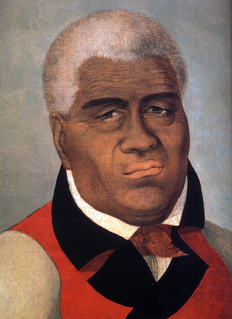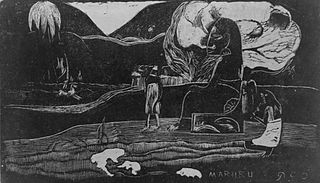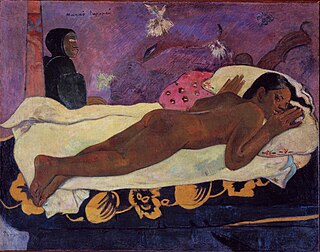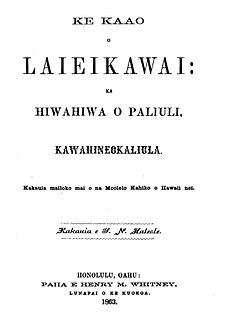
Kamehameha I, also known as Kamehameha the Great, was the conqueror and first ruler of the Kingdom of Hawaii. The state of Hawaii gave a statue of him to the National Statuary Hall Collection in Washington, D.C. as one of two statues it is entitled to install there.
Māui (Maui) is the great culture hero and trickster in Polynesian mythology. Very rarely was Māui actually worshipped, being less of a deity and more of a folk hero. His origins vary from culture to culture, but many of his main exploits remain relatively similar.

Hina is the name assigned to a number of Polynesian deities. The name Hina usually relates to a powerful female force who has dominion over a specific entity. Some variations of the name Hina include Sina, Hanaiakamalama, and Ina. Even within a single culture, Hina could refer to multiple goddesses and the distinction between the different identities are not always clear. In Hawaiian mythology, the name is usually paired with words which explain or identify the goddess and her power such as Hina-puku-iʻa (Hina-gathering-seafood) the goddess of fishermen, and Hina-ʻopu-hala-koʻa who gave birth to all reef life.
In Hawaiian religion, Hiʻiaka is a daughter of Haumea and Kāne.
In Hawaiian mythology, an ʻaumakua is a personal or family god that originated as a deified ancestor, and which takes on physical forms such as spirit vehicles. An 'aumakua may manifest as a shark, owl, bird, octopus, or inanimate objects such as plants or rocks. The word ʻaumakua means ancestor gods and is derived from the Hawaiian words au which means period of time or era, and makua meaning parent, parent generation, or ancestor.Hawaiians believed that deceased family members would transform into ʻaumakua and watch over their descendants with a loving concern for them while also being the judge and jury of their actions.

In Hawaiian mythology, Kamapuaʻa is a hog-man fertility superhuman associated with Lono, the god of agriculture. The son of Hina and Kahikiula, the chief of Oahu, Kamapuaʻa was particularly connected with the island of Maui.

In Hawaiian religion, Pele is the goddess of volcanoes and fire and the creator of the Hawaiian Islands. Often referred to as "Madame Pele" or "Tūtū Pele" as a sign of respect, she is a well-known deity within Hawaiian mythology and is notable for her contemporary presence and cultural influence as an enduring figure from ancient Hawaii. Epithets of the goddess include Pele-honua-mea and Ka wahine ʻai honua.

Huli jing are Chinese mythological creatures usually capable of shapeshifting, who may either be benevolent or malevolent spirits, among which the nine-tailed fox, jiuweihu, is the most famous.

The Makahiki season is the ancient Hawaiian New Year festival, in honor of the god Lono of the Hawaiian religion.
Paʻao is a figure from Hawaii. He is most likely a Hawaiian historical character retold through Hawaiian legend. According to Hawaiian tradition and folklore, he is said to have been a high priest from Kahiki, specifically "Wewaʻu" and "ʻUpolu." In Hawaiian prose and chant, the term "Kahiki" is applied in reference to any land outside of Hawai'i, although the linguistic root is conclusively derived from Tahiti. "Wewaʻu" and "Upolu" point to actual places in the Society Islands, Samoa, and Hawaiian scholars and royal commentators consistently claim Paʻao came from Samoa; he was a Samoan priest with properties in both Tonga and Samoa. He arrived on the north shores of the Big Island and named it "Upolu" after Samoa main village.

A heiau is a Hawaiian temple. Made in different architectural styles depending upon their purpose and location, they range from simple earth terraces, to elaborately constructed stone platforms. There are heiau to treat the sick, offer first fruits, offer first catch, start rain, stop rain, increase the population, ensure the health of the nation, achieve success in distant voyaging, reach peace, and achieve success in war (luakini).

In Hawaiian religion, Māui is a culture hero and ancient chief who appears in several different genealogies. In the Kumulipo, he is the son of ʻAkalana and his wife Hina-a-ke-ahi (Hina). This couple has four sons, Māui-mua, Māui-waena, Māui-kiʻikiʻi, and Māui-a-kalana. Māui-a-kalana's wife is named Hinakealohaila, and his son is named Nanamaoa. Māui is one of the Kupua. His name is the same as that of the Hawaiian island Maui, although native tradition holds that it is not named for him directly, but instead named after the son of Hawaii's discoverer.
In Samoan legend, the mythological figure Tiʻitiʻi Atalaga appears in legends very similar to those recounting the tales of the demigod Māui, found in other island cultures. In one such legend, which is almost identical to the New Zealand fire myth of Māui Tikitiki-a-Taranga, he succeeds in bringing fire to the people of Samoa after a battle with the earthquake god, Mafuiʻe. During the battle, Ti'iti'i breaks off one of Mafui'e's arms, forcing him to agree to teach him of how fire had been concealed by the gods in certain trees during the making of the world. The people of Samoa were thankful to Ti'iti'i for breaking off Mafui'e's arm, as they believed that he was less able to create large earthquakes as a result.

Hawaiian religion refers to the indigenous religious beliefs and practices of native Hawaiians, also known as the kapu system. Hawaiian religion is based largely on the tapu religion common in Polynesia and likely originated among the Tahitians and other Pacific islanders who landed in Hawaiʻi between 500 and 1300 AD. It is polytheistic and animistic, with a belief in many deities and spirits, including the belief that spirits are found in non-human beings and objects such as other animals, the waves, and the sky. Only during the reign of Kamehameha I was there a time period where a ruler from Hawaii island attempted to impose a singular "Hawaiian" religion on all the Hawaiian islands that was not Christianity.

Samuel Mānaiakalani Kamakau was a Hawaiian historian and scholar. His work appeared in local newspapers and was later compiled into books, becoming an invaluable resource on the Hawaiian people, Hawaiian culture, and Hawaiian language while they were disappearing.

There was widespread belief in ghosts in Polynesian culture, some of which persists today. After death, a person's ghost would normally travel to the sky world or the underworld, but some could stay on earth. In many Polynesian legends, ghosts were often involved in the affairs of the living. Ghosts might also cause sickness or even invade the body of ordinary people, to be driven out through strong medicines.
Kamaloʻohua was a High Chief in ancient Hawaii, according to Hawaiian mythology, and is mentioned in old legends and chants. He was Moʻi - King of the island of Maui. He was the king of Maui island.

S. N. Haleʻole was a leading Native Hawaiian writer and historian of the Kingdom of Hawaii. He is noted for authoring The Hawaiian Romance of Laieikawai, the first fictional work of literature produced by a Native Hawaiian.
Moʻo are shapeshifting lizard spirits in Hawaiian mythology.
Kapaemahu refers to four stones on Waikiki Beach that were placed there as tribute to four legendary mahu who brought the healing arts from Tahiti to Hawaiʻi centuries ago. It is also the name of the leader of the healers, who according to tradition, transferred their spiritual power to the stones before they vanished. The stones are currently located inside a City and County of Honolulu monument in Honolulu at the western end of Kuhio Beach Park, close to their original home in the section of Waikiki known as Ulukou. Kapaemahu is considered significant as a cultural monument in Waikiki, an example of sacred stones in Hawaiʻi, an insight into indigenous understandings of gender and healing, and the subject of an animated film.










